LINEARE Thunberg, 1784
Synonyms :
Sedum lineare var. floribundum Miquel (1866)
Sedum lineare var. minus Miquel (1866)
Sedum obtuso-lineare Hayata (1913)
Sedum lineare fa. variegatum Praeger (1921)
Sedum lineare var. robustum Praeger (1921)
Sedum lineare var. albomarginatum Makino ex Megata (1952).
Distribution :
Southeastern China, Japan, Taiwan ; low mountains, rocks on grassy slopes etc. ; probably naturalized in eastern Europe.
Description (by 't Hart & Bleij in IHSP, 2003) :
Perennial herbs with ascending very slender fleshy stems 10 - 30 cm.
Leaves in whorls of 3 - 4, linear to broadly oblanceolate, obtuse to subacute, rather flat, 7 - 30 x ± 2 mm.
Inflorescences : Flowering branches ascending, very slender, inflorescences lax few- to many-flowered cymes of (1-) 2 (-3) sometimes forked cincinni, bracts linear.
FIowers 5-merous, sessile, sepals basally free, shortly spurred, often unequal, linear-lanceolate, subobtuse to subacute, 1,5 - 7 (-11) x 2 mm, petals oblong, subobtuse, shortly mucronate, slightly narrowed at the base, yellow, 4 - 9 mm.
Cytology: n = 36 (Uhl & Moran 1972).
Fröderström (1931) included S. subtile and S. zentaro-tashiroi into the synonymy here. Ohwi (1965: 497) considered the latter as a synonym of S. subtile, which he regarded as distinct from S. lineare. Fu & Fu (1984: 144, 157) also treated S. lineare and S. subtile as distinct species. They gave S. obtuso-lineare as a synonym of S. lineare, while Tang & Huang (1989), however, considered S. obtuso-lineare as a synonym of S. mexicanum, whose purported American origin still has to be ascertained. Finally, Fu & Ohba (2001: 249-250) treat S. obtuso-lineare as synonym of S. yvesii and interprete S. anhuiense as further synonym of S. lineare.
Praeger (1921a) distinguished a large form of S. lineare as var. robustum. Generally, S. lineare var. contractum is included in S. sarmentosum, whereas S. lineare var. floribundum is either included in S. alfredii or S. bulbiferum.
Whether this species is really indigenous in Japan remains doubtful according to Ohba (2001: 29), although it was originally described on the base of material from that country.
Ray Stephenson (Sedum, Cultivated Stonecrops, 1994, pp 161 - 162) :
Common name : O-no-mannengusa
Sedum lineare is exceptionally common in its variegated form, which is invariably grown in a hanging basket. Very long, rising, creeping, then falling stems, carry flat, linear, acute leaves in whorls of three [or four]. Yellow flowers of summer, on flat-topped, lax, few-flowered inflorescences, are hardly ever produced on variegated plants. It can be most confusing to read that synonyms of this species comprise a long list of most other Oriental species, a consequence of Fröderström, in particular, generally ignoring vegetative form and lumping together all Far Eastern species with similar flowers. Here, following more recent opinion, S. subtile, S. zentaro-tashiroi, and S. makinoi are treated as distinct species.
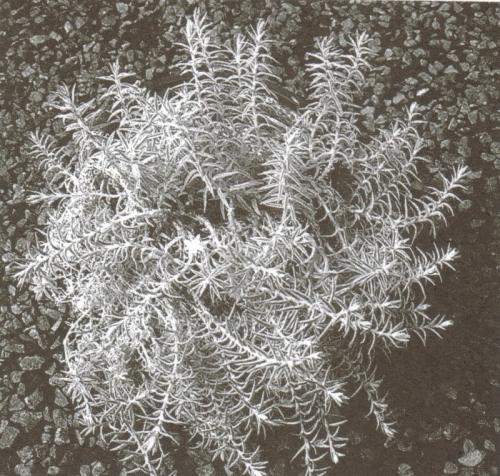
Sedum lineare, the commonly cultivated variegated form in a hanging basket 6 in (15 cm) in diameter.
Habitat : The true habitat is confused by garden escapes in the Japanese islands of Honshu, Shikoku, and Kyushu, but the species is indigenous to the Ryukyu Islands and possibly mainland China.
Main points of distinction : This stonecrop is only likely to be confused with Sedum sarmentosum, which also can produce 30-cm (12-in) creeping stems with long, spurred ternate leaves. Cytologically, S. sarmentosum is distinct from S. lineare, which has n = 36. Uhl and Moran (1972) noted that the related S. sarmentosum may have approximately the same n number, but the latter usually displays considerable irregularity at meiosis, suggesting it is a hybrid. Width and thickness of leaf are the only real guides upon which the amateur can rely to distinguish the two species : S. lineare has thin, narrow leaves that are not very fleshy, those of S. sarmentosum are leathery and more lanceolate. Both stonecrops have free sepals without spurs, but those of S. lineare tend to be upright and stand up between petals. Highly fused carpels only spread a little. Sedum lineare resembles, and is obviously closely related to, S. mexicanum, which has nearly terete leaves in whorls of four.
Variation : Praeger described Sedum lineare var. robustum, but all the plants I have received with this label have turned out to be S. sarmentosum. If grown outside, S. lineare becomes more robust, more upright, and has shorter, denser shoots. Sedum lineare fa. variegatum has leaves with cream edges and is a very popular potted plant for the home, although it tends to be leggy indoors.
Horticulture : Frosts tend to sear plants at ground level, but they often regenerate. Even after a bitter winter, end pieces left blowing around, if pushed into soil, soon start growing. It is prudent to keep some stock under cover in the worst months. In milder areas, this species and its variegated form produce very dense ground cover, pouring over the edges of stone troughs or raised beds.
Like S. sarmentosum falls to bits in summer after heavy rain.
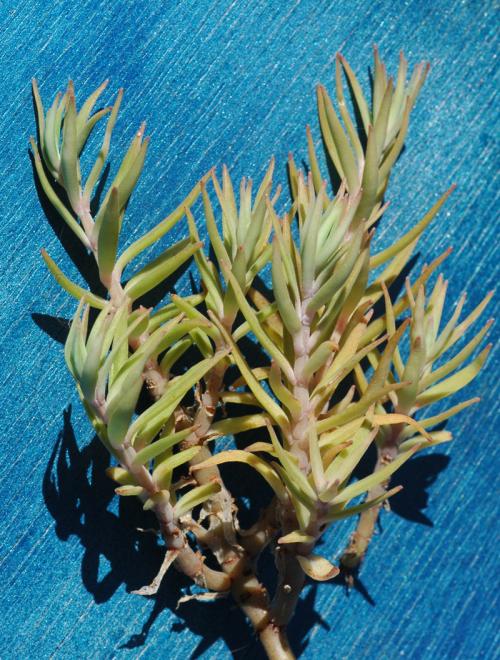
Photo Ray Stephenson
Sedum lineare fa. variegatum, plant in cultivation with a non variegated branch (reversion) / plante en culture, avec une branche aux feuilles non panachées (réversion) :
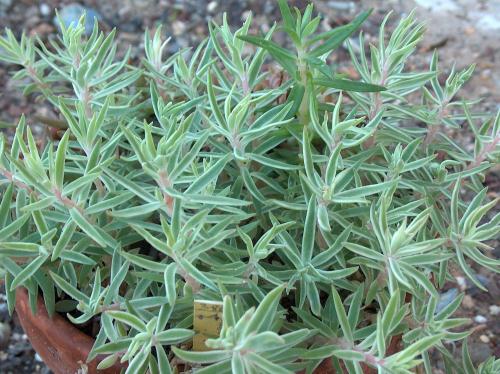
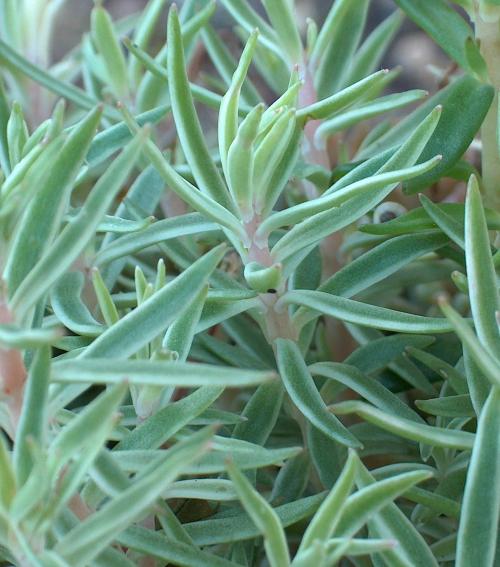
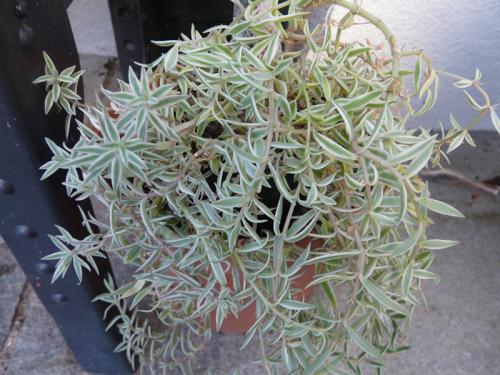
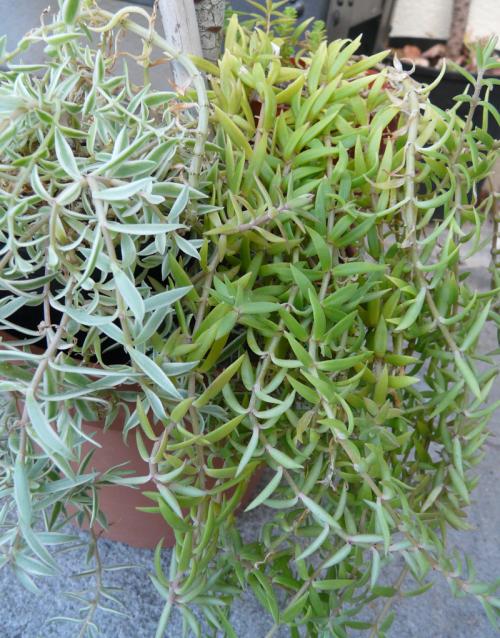
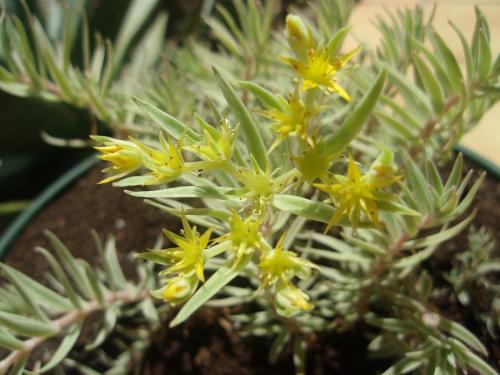
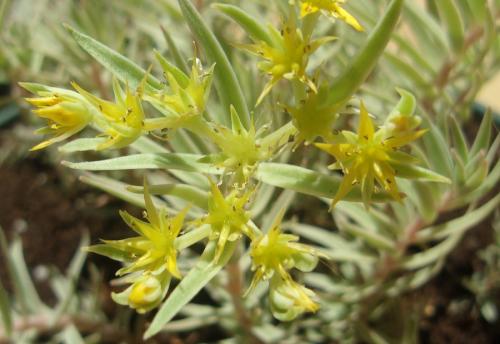
Photos Christophe Camassel